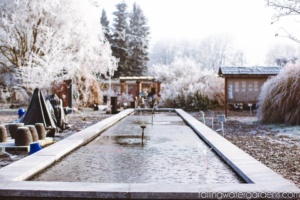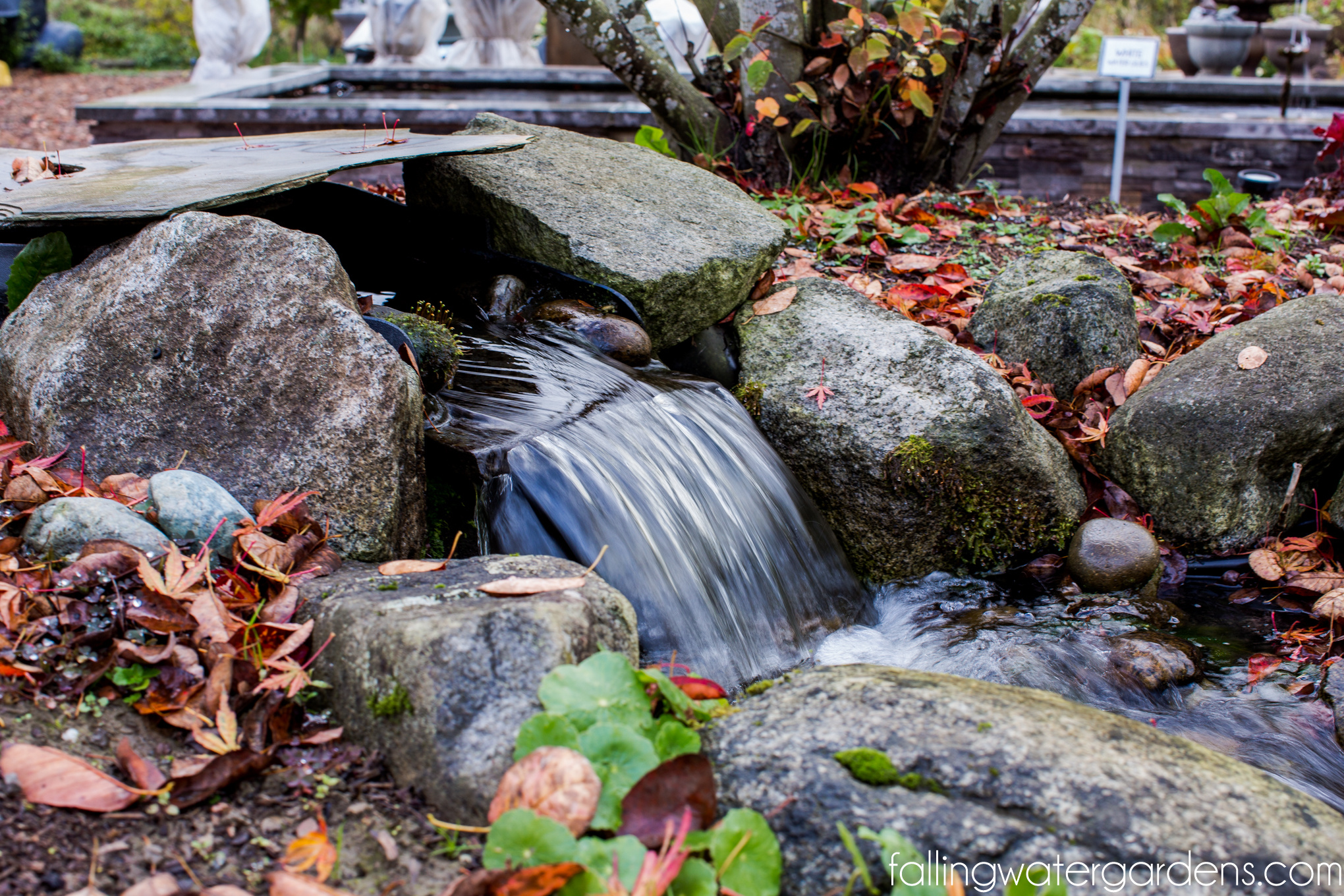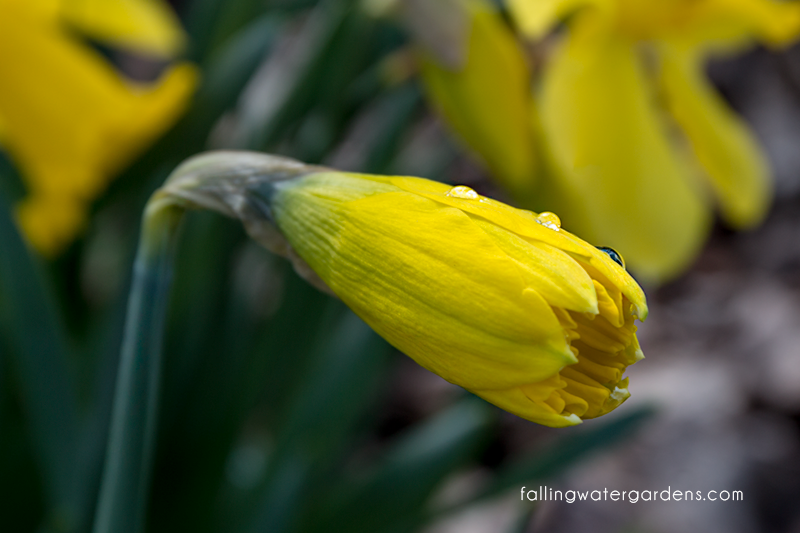HOW-TO
POND & FISH CARE IN FREEZING WEATHER
 Is freezing weather in the forecast? Here’s how to keep your fish and pond equipment safe.
Is freezing weather in the forecast? Here’s how to keep your fish and pond equipment safe.
FISH
Koi and Goldfish are extremely hardy. The cold weather doesn’t affect them too much.
As water temperatures decrease, you will notice your fish slowly making their way to the bottom of the pond. The water at the bottom is warmer than the water at the top. The fish will remain down there, in hibernation mode, waiting for warmer spring temperatures.
WATER MOVEMENT
- When it’s practical, suck water from the surface rather than the bottom of the pond. If your pump is sitting at the bottom of the pond and it’s possible to do so, try to lift it closer to the surface. There is no need to do anything else with skimmers because they are already sucking from the surface. If you have a more elaborate plumbing system, switch to surface suction instead of bottom suction, if possible.
FREEZING POND
 If the pond begins to ice up, ensure that at least one small hole remains open at the top of the pond. Keeping an opening in the pond surface allows oxygen into the water. Decomposing plant material and fish waste produce toxic gasses that will be able to escape if there is a hole at the top of the pond.
If the pond begins to ice up, ensure that at least one small hole remains open at the top of the pond. Keeping an opening in the pond surface allows oxygen into the water. Decomposing plant material and fish waste produce toxic gasses that will be able to escape if there is a hole at the top of the pond.- Some great ways to keep an opening are to keep the water feature running; when the water returns to the pond it will usually keep an opening in the ice. Float a rubber play ball on the surface of the pond; the ball floating on the surface will often keep a hole open. Install an aerator in the bottom of the pond; the bubbles will keep an opening on the surface. Install a pond deicer; the deicer heats a small hole in the pond.
- If the pond completely ices over, do not break the ice. This is can cause concussive damage to the fish’s internal organs. Smashing ice can also cut your liner. The best way to open a hole in a frozen pond is to take a boiling pot of water carefully out to the pond and place the entire pot of boiling water on the ice. Do not pour the boiling water on the ice, just set the hot pot of water on the ice. Repeat this as the water cools in the pan until you’ve opened a hole in the ice.
 PLANTS
PLANTS
- Most aquatic plants are dormant by now. If the pots are sitting high in the pond you can temporarily drop them lower in the pond to protect them from the freezing weather. Just remember to lift them back up after the freeze danger has passed.
POND EQUIPMENT
- It’s always a bit of a gamble how to manage your equipment during a freeze. In almost all instances Falling Water Designs suggests to try and keep your pond running during a freeze. In many ponds it is nearly impossible or impractical to try and get all the water out of the equipment and the plumbing. If you cannot completely drain the equipment and the lines it is safer to keep the pond running because running water is less likely to freeze even in below freezing conditions. If we can keep the water running the pipes and equipment are far less likely to freeze and break.
 Sometimes in a prolonged freeze the waterfall/stream will ice up to the point that water is overflowing the stream instead of returning to the pond. Another problem that can happen is ice crystals will form on the pond surface to the point that the skimmer will clog and the pump won’t work. If this happens you will be forced to turn off the pump and your equipment and then take additional precautions to try and keep equipment from being damaged. The good news is that if you are forced to turn off the pump cold water holds much more oxygen than warm water so your fish don’t really need the pump running in cold weather.
Sometimes in a prolonged freeze the waterfall/stream will ice up to the point that water is overflowing the stream instead of returning to the pond. Another problem that can happen is ice crystals will form on the pond surface to the point that the skimmer will clog and the pump won’t work. If this happens you will be forced to turn off the pump and your equipment and then take additional precautions to try and keep equipment from being damaged. The good news is that if you are forced to turn off the pump cold water holds much more oxygen than warm water so your fish don’t really need the pump running in cold weather.
PUMPS
- If your pump is submersible you don’t really have to worry. Your water feature would have to be very shallow for freezing water to damage a submersible pump. If you pump is inline it is very important to keep it running during the freeze or you will have to completely drain it. On most inline pumps there are two drain plugs at the bottom that will have to be opened to get all the water out of the pump.
PLUMBING AND CHECK VALVE
- Most water features have a check valve between the pump and the top of the waterfall/stream. The check valve keeps water in the line on the way up to the top of the waterfall. It is not possible for most people to remove their check valve to drain the line so in many water features there is water in the plumbing from the pump to the top of the waterfall. If you turn off your pond that water will stay in the line and can freeze. This is the over-riding reason we suggest that most water features be kept running.
UV STERILIZER
- UV sterilizers are expensive and prone to breakage in freezing weather. If you system will allow you to bypass the UV you should do so, remove the UV, drain it completely and store it in the garage. Unfortunately very few ponds are plumbed for this. Your second option is to remove the transformer and then unscrew the quartz sleeve and light bulbs. We sell caps that allow everything but the housing to be removed and stored. This way you can keep the water running and in a worse case situation only the housing is damaged. Your third option is to just keep the water running through the equipment and usually the water won’t freeze and damage anything. Temporarily plugging the sterilizer back in will generate some heat and possibly keep it from freezing.
PRESSURIZED BEAD and/or SAND FILTERS
- Bead and sand filters are expensive and prone to breakage in freezing weather. While some limited amount of biological activity occurs, most bacteria die at temperatures below 45 degrees. Falling Water Designs suggests that it is more important to preserve costly equipment than keep the limited amount of bacteria alive, so the filter should be drained for the winter. Watch our video here to learn how to drain your filter. If you are going to keep the pond running, the filter should be set to “bypass” or “recirculate” and then the bottom drain should be opened to allow the water to drain from the bottom of the filter. Do not allow standing water in the bottom of the filter when the valve is set to bypass, recirculate or “winter”. Do not try and keep the filter running in the normal filter mode during freezing weather. The water in the filter can freeze and break the interior plumbing or the exterior housing. In bypass or recirculate mode the water is just going through the valve head at the top and not the media at the bottom which is why you can drain the bottom. If you are not going to run your pump during the freeze then you should drain the bottom and put the filter valve on “winter”. The winter setting will not allow water to run through the system so it is only used if you will be shutting down your entire pond and pump.
PROBLEMS WITH RUNNING THE POND
 In almost all instances Falling Water Designs suggests to try and keep your pond running during a freeze. This is the easiest and in most instances the most practical solution. However, if you go this route and the waterfall/stream becomes iced to the point that water is leaving the pond, or if your skimmer becomes clogged with ice crystals to where you have to turn off the pump, or if the power goes out and the temperature is below freezing, you will have to take additional precautionary steps. If the pump is not running you will need to go out and disconnect the UV sterilizer and drain it completely of water and store it in the garage. You will also have to put the pressurized filter on “winter” and ensure that you did drain the beads. Finally when practical you should drain any exposed pipes of water to minimize breakage. Ensure that you keep one small hole open on the surface of the pond.
In almost all instances Falling Water Designs suggests to try and keep your pond running during a freeze. This is the easiest and in most instances the most practical solution. However, if you go this route and the waterfall/stream becomes iced to the point that water is leaving the pond, or if your skimmer becomes clogged with ice crystals to where you have to turn off the pump, or if the power goes out and the temperature is below freezing, you will have to take additional precautionary steps. If the pump is not running you will need to go out and disconnect the UV sterilizer and drain it completely of water and store it in the garage. You will also have to put the pressurized filter on “winter” and ensure that you did drain the beads. Finally when practical you should drain any exposed pipes of water to minimize breakage. Ensure that you keep one small hole open on the surface of the pond.
Please note that we’ve updated our newsletter format. You may navigate through this newsletter by clicking on the page numbers below.



